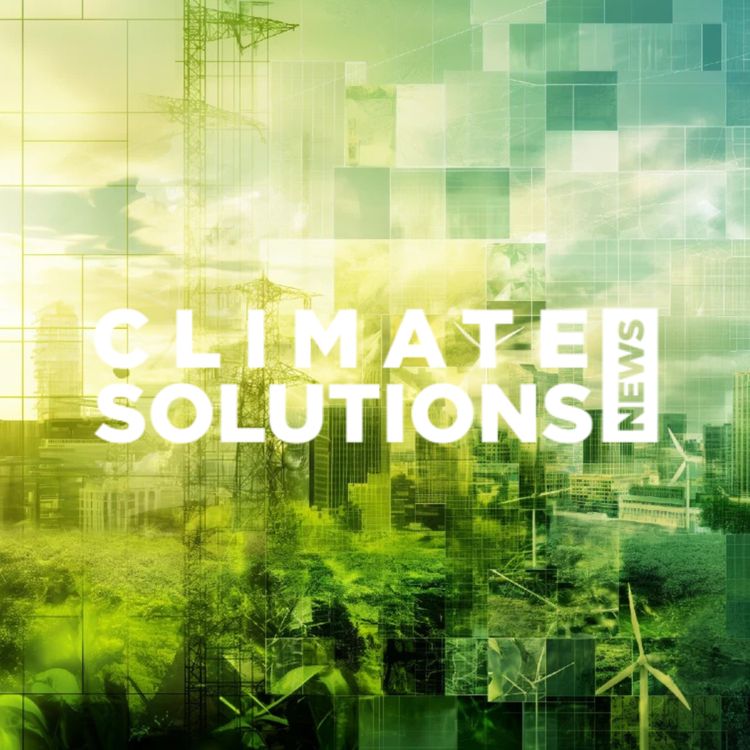Share

Climate Solutions News
Saving Arctic Sea Ice: Can Technology Reverse the Crisis?
Arctic sea ice has reached alarming new lows, melting faster than ever and threatening global climate stability. In this in-depth interview, Climate Solutions News publisher Dominic Shales talks exclusively with Dr Joshua Elliott, Chief Scientist at Renaissance Philanthropy, about innovative technologies that could halt or even reverse this crisis.
Dr Elliott discusses promising approaches like cloud-seeding and sea ice thickening, their feasibility, scalability, and potential to make a meaningful difference. He also examines more controversial geoengineering methods, including stratospheric aerosol injection, weighing their benefits against critical environmental and geopolitical risks.
Listen now to understand the urgent reality of Arctic ice depletion, explore cutting-edge solutions, and find out whether technology can deliver answers fast enough to protect our planet’s future.
More episodes
View all episodes

16. Peatlands, Carbon And The Climate Power Of Scotland’s Bogs
29:21||Ep. 16In this episode, Dominic Shales speaks with Freddie Ingleby, Managing Director of Caledonian Climate, about one of the most powerful and overlooked climate solutions, peatlands.Peatlands store more carbon than all the world’s forests combined, yet when degraded they become major sources of emissions. Ingleby explains what peatlands are, why Scotland is globally significant, and how restoring damaged bogs can deliver long-term emissions reductions, biodiversity recovery, and improved water security.The conversation explores how peatland restoration works on the ground, from re-wetting landscapes to reshaping eroded peat, and why these projects require decades-long monitoring. Despite appearing low-tech, the sector is increasingly using digital mapping, sensors, and artificial intelligence to improve accuracy, integrity, and investor confidence.Ingleby also discusses the role of private finance in scaling nature-based solutions, including Caledonian Climate’s recent partnership with Diageo, and what landowners gain from restoring peatlands.A practical, grounded discussion on how nature, science, and technology intersect in the fight against climate change.You can also check out our full article at: https://climatesolutions.news/spotlight/peatlands-carbon-and-the-climate-power-of-scotlands-bogs Keywords:peatland restoration, carbon storage, climate change, Caledonian Climate, biodiversity, technology in restoration, corporate partnerships, landowner benefits, environmental impact, sustainabilityTakeaways:Peatlands are crucial for carbon storage, holding more carbon than all forests combined.Caledonian Climate aims to restore peatlands at scale, having restored 10,000 hectares since 2021.Restoration projects can lead to over 2.1 million tonnes of carbon reductions.The restoration process involves re-profiling land, re-vegetating, and re-wetting peatlands.Technology, including GIS and AI, is enhancing restoration efforts and monitoring.Corporate partnerships, like the one with Diageo, are vital for funding restoration projects.Landowners can benefit from restoration through improved biodiversity and potential carbon credits.Public support for peatland restoration is high, with over 75% in favour.Modelling carbon output and benefits is essential for project success.Engagement and education about peatlands are important for public understanding.
15. Direct Air Capture Moves to the Main Stage at COP30
28:57||Ep. 15Direct air capture took an unexpected step forward at COP30, even as the summit delivered few major breakthroughs. In this interview, Tom Rollason, Head of Policy and Partnerships at Mission Zero Technologies, explains why engineered carbon removals gained unprecedented attention in Brazil and how the sector is shifting from niche innovation to essential climate infrastructure.We discuss Mission Zero’s electrochemical DAC system, the company’s pilot deployments in the UK and Canada, the challenges of scaling energy-efficient removal technologies and the evolving policy landscape across the US, UK and Canada. Rollason also reflects on market signals, financing gaps, long-term offtake demand and the implications of Breakthrough Energy winding down its policy work.This conversation offers a clear, grounded look at the future of engineered removals as governments confront overshoot, adaptation and the need for durable carbon solutions.Watch the full interview to understand where direct air capture is heading and why the next few years will be decisive for the sector.Also check out the article on Climate Solutions News: https://climatesolutions.news/spotlight/direct-air-capture-moves-from-the-margins-to-the-main-stageTopics covered:Introduction to Climate Solutions and Mission Zero TechnologiesUnderstanding Direct Air Capture TechnologyApplications and Uses of Captured CO2Insights from COP 30 and Carbon Dioxide RemovalsBarriers to Scaling Direct Air CaptureFinancing and Market Dynamics in Carbon RemovalFuture Outlook for Direct Air Capture
14. Turning Waste Carbon into Fuel
21:38||Ep. 14OXCCU has raised $28 million to scale its technology that converts waste carbon and green hydrogen into sustainable aviation fuel (SAF). In this episode of the Climate Solutions News podcast, Andrew Symes, Co-founder and CEO of OXCCU, explains how their process works, what the new funding will support, and why scaling SAF is critical as airline emissions continue to rise.We discuss:The $28m Series B funding round and OXCCU’s investorsPlans for the next demonstration plant at Oxford AirportHow OXCCU’s catalyst turns waste carbon and hydrogen into jet fuelThe challenge of sustainable feedstocksWhy SAF costs about 2x fossil jet fuel, and how that gap can closeThe role of airlines, mandates, and government policy in accelerating SAF✈️ Aviation accounts for 2–3% of global CO₂ emissions, and demand is growing fast. SAF is one of the few near-term solutions that can make a difference.📌 Read more at https://climatesolutions.news/business/oxccu-secures-28m-to-scale-sustainable-jet-fuel-production
13. Philanthropy and Carbon Removal
24:44||Ep. 13How can philanthropy accelerate the growth of carbon removal? In this interview, Climate Solutions News publisher Dominic Shales speaks with Adam Fraser, Chief Executive of TerraSet, about the role of donors in scaling breakthrough technologies.Fraser explains how TerraSet channels philanthropic capital into early stage carbon removal projects through strategic pre-purchases, supporting a diverse portfolio that includes Climeworks, Heirloom, Octavia Carbon, TerraFixing, and Carbon Run.Key topics covered:Why less than 0.1% of global philanthropy goes to carbon removalHow pre-purchases provide catalytic funding for startupsAddressing skepticism and raising awareness of carbon removalExamples of innovative projects across Africa, Canada, and beyondThe role of governments alongside private donorsWhy “everyone can play a role” in climate solutions🔗 Learn more: https://www.terrasetclimate.org/Subscribe to Climate Solutions News for interviews, analysis, and reporting on the technologies driving the net-zero transition.#CarbonRemoval #ClimateSolutions #Philanthropy #CarbonCapture
12. Europe’s Defence Buildup Could Blow a Hole in Climate Goals
22:46||Ep. 12As Europe ramps up defence spending, what’s the hidden cost to the climate?In this episode of the Climate Solutions News podcast, we speak with Alexis Normand, CEO of carbon accounting platform Greenly, about their new report Rearming Europe: Counting the Carbon Bootprint. The report reveals how NATO’s growing military budgets—and the EU’s €800 billion ReArm Europe initiative—could generate emissions rivaling the annual carbon footprint of the Netherlands, yet remain almost entirely unreported.Alexis explains why military emissions are such a major blind spot in climate policy, how Greenly calculated the scale of the problem, and what steps governments could take to decarbonise defence without compromising security.🎧 A must-listen for anyone interested in the intersection of geopolitics, emissions accountability, and climate action.Keywordsmilitary emissions, carbon footprint, climate change, NATO, Greenly, emissions reporting, defense spending, EU Green Deal, decarbonization, climate policyTakeawaysThe military accounts for approximately 5.5% of global greenhouse gas emissions.NATO's emissions are projected to reach 256 million tonnes of CO2 equivalent in 2024.Military emissions are often unreported and unregulated, creating a significant loophole in climate commitments.Greenlee aims to simplify emissions reporting for businesses, including those in the defense sector.The EU's rearmament initiative could lead to an additional 150 million tonnes of CO2 emissions.Security concerns should not overshadow the need for emissions reduction in military operations.Comprehensive emissions reporting is essential for understanding military impacts on climate change.Innovative solutions like virtual training can help reduce military emissions.There is a need for binding emissions targets and transparency in military budgets.The military sector's spending surge presents an opportunity for broader decarbonization efforts.
11. Can AI Help Solve the Climate Crisis?
23:01||Ep. 11Climate Solutions News speaks to Dr Mattia Romani, co-author of a groundbreaking new study published in npj Climate Action, which explores how artificial intelligence could dramatically cut global carbon emissions.The report, produced by the Grantham Research Institute at LSE and Systemiq, finds that AI applications in power, transport and food systems could reduce emissions by 3.2 to 5.4 billion tonnes of CO₂ annually by 2035 — more than the current emissions of the entire EU.Dr Romani breaks down the five key ways AI can support climate action:Optimising complex systems (like energy grids and transport networks)Accelerating technology discovery (especially in batteries and alternative proteins)Nudging low-carbon behaviourModelling climate systems and policy impactsEnhancing resilience and disaster preparednessHe also addresses AI’s own energy footprint, the need for intentional public policy, and why this moment is a “once-in-a-generation opportunity” for governments and tech leaders to align climate and digital strategies.
10. Losing Sight of the Sky: Why Data Cuts Threaten Climate Innovation
25:49||Ep. 10What happens when governments cut the very data that helps us forecast extreme weather, respond to climate risks, and power clean tech innovation?In this Climate Solutions News interview, host Dominic Shales speaks with Kelly Wanser, Executive Director of SilverLining, about the critical loss of atmospheric monitoring capabilities in both the US and UK. From NOAA’s potential lab closures to the UK Met Office dropping key aerosol programmes, these decisions are creating dangerous blind spots at the worst possible time.Kelly explains why this data matters—not just for weather forecasts, but for everything from AI-driven climate modelling to preparing for future climate interventions like solar radiation modification (SRM). She also breaks down what SRM is, what it isn’t, and why research—not deployment—is where SilverLining is focused.📌 Subscribe for more interviews on real-world climate tech📰 Read the full article: https://climatesolutions.news/spotlight/losing-sight-of-the-sky-why-data-cuts-threaten-climate-innovation 🌐 Learn more about SilverLining: https://www.silverlining.ngo/TakeawaysKelly Wanser emphasizes the importance of atmospheric monitoring.NOAA cuts could severely impact climate data and innovation.The US has unique capabilities in atmospheric research.Solar radiation modification is a potential quick response to climate change.The UK Met Office has also faced cuts in climate-related programs.Aerosols play a significant role in climate regulation.Data is crucial for AI-driven climate solutions.The future of climate innovation depends on sustained research funding.There are opportunities for innovative approaches in climate science.Public-private partnerships could drive future climate solutions.#ClimateTech #AtmosphericScience #Geoengineering #ClimateInnovation #SolarRadiationModification
8. How Should We Deal With Nuclear Waste?
16:51||Ep. 8Nuclear power is back in the spotlight as countries look for reliable, low-carbon energy sources - but the question of what to do with radioactive waste still looms large.In this episode, we explore three practical, science-backed approaches to managing nuclear waste around the world. We begin in Finland, where engineers are preparing to open the world’s first deep geological repository, a facility designed to keep spent fuel isolated for 100,000 years. Then we look at how the U.S. is funding a new wave of companies aiming to make nuclear waste treatment safer, faster, and more affordable. Finally, we head to Australia, where researchers at CSIRO are turning radioactive byproducts into a durable ceramic that could offer a long-term storage solution.Together, these stories show how science, engineering, and public policy are converging to tackle one of nuclear energy’s most persistent challenges.🔗 Read the full stories at climatesolutions.news/tag/nuclear-waste